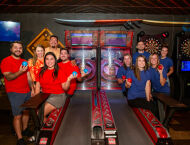Eat
 DC To-GoGo's Adam Fry + Josh Saltzman. Photo by Rachel Fink.
DC To-GoGo's Adam Fry + Josh Saltzman. Photo by Rachel Fink.
The State of Takeout in the District
March 12, 2021 @ 10:00am
A year into the pandemic, restaurant owners and local delivery partners reflect on the challenges of the past year, how takeout is evolving and what they see for the future of delivery.
“There is no way I would have predicted where we would’ve ended up.”
Fresh off a stellar first year in business that brought award nominations and positive reviews from food critics and locals alike, general manager Carey Tang and her team at Rooster & Owl had no idea their restaurant’s business model would be flipped on its head. Once the pandemic hit, the dinner-only, sit-down-only spot in Columbia Heights had to quickly transform into a takeout and delivery operation.
With the current capacity limitations, the restaurant now operates on takeout exclusively, although the road to get there was not without its trials. From setting up the initial infrastructure to sourcing takeout packaging and dealing with unforeseen challenges (like finding adequate storage space for said takeout packaging), transitioning was tricky.
And then there was the food. Prior to the pandemic, Rooster & Owl was known for its shared plates and tasting menu-style experience. Beautifully presented courses suited for a prix-fixe meal at the restaurant were the opposite of what was ideal for delivery: seafood that would not travel well, ingredients prone to melting and wilting. In response, executive chef Yuan Tang and his team focused on proteins that would retain their integrity during transit and updated the menu to a three-course format.
Javier Candon, owner of Joselito Casa De Comidas in Capitol Hill, faced similar challenges when forced to switch operations to accommodate for delivery and takeout. Joselito’s Spanish tapas menu would typically offer dishes in three different sizes for dine-in, including a family-style portion. Those all had to be updated to better fit a takeout model.
“We had to reinvent ourselves to put everything together in terms of a more appropriate menu that will travel better, but also the to-go platform,” Candon says.
Growing Pains
With new packaging ordered and menus retooled to fit within the confines of delivery, the next challenge was getting food out to guests.
“We were really struggling with reliability,” Tang says about when Rooster & Owl initially offered delivery fulfilled through online ordering platform Tock.
Drivers from third-party delivery services would arrive late and the restaurant had little control over the amount of time that it would take for meals to get to guests. Not willing to compromise food quality (Tang notes some delays were hours long), the team decided to halt delivery through larger platforms like Postmates and DoorDash.
Those delivery woes were echoed by fellow restaurateurs.
Although Paulos Belay’s burgeoning business was well-suited for takeout (his Detroit-style pizza concept Motown Square Pizza launched at the end of August 2020 in Northeast D.C.), he still experienced issues ranging from quality control to missing deliveries. Orders placed through Motown Square’s website were automatically fulfilled by DoorDash for delivery, and he’s experienced delays and situations where the pizza never got to its final destination.
“Somebody paid money to get our pizza and it just never showed up,” says Belay. The unsettling situation that left him scrambling.
Those issues coupled with high fee structures from large third-party delivery apps have led some business owners to look for other options.
Think Local First
As a restaurant owner frustrated with larger third-party delivery options, Adam Fry and his business partners decided to take matters into their own hands. The owners of Shaw bar Ivy and Coney launched their own grassroots ordering and delivery platform, DC To-GoGo, as a local alternative that prioritizes the interests of restaurants.
“What we’ve been doing is trying to lean into a model of sustainable support for restaurants, rather than pure profit,” Fry says.
Fees for participating restaurants are much lower than on larger delivery apps, ranging from 5 to 15%. Another focus? Taking a human-first approach.
“People are recognizing that we’re approaching the business as an actual hospitality business,” Fry adds. “We have real people doing support.”
And on the administrative side, the company’s couriers are employed, paid a living wage and receive set hours as well as a full range of benefits.
Although the platform doesn’t have the same level of capital as some of its larger national counterparts, DC To-GoGo continues to grow and evolve.
Fry notes, “We certainly have the passion [and] motivation to help the restaurants, because at the end of the day, we’re all D.C. residents. The more jobs you keep in D.C. [and] the more work you keep in D.C., the better D.C. is going to get.”
Joselito is a recent addition to the platform, and in the few short weeks since joining, Candon says DC To-GoGo has been the top source for the restaurant’s takeout business. He appreciates the professionalism from hospitality veterans who “know exactly how it works.” He’s noticed couriers picking up and delivering meals efficiently, and he’s also heard great feedback from customers.
Motown Square Pizza also signed on as a restaurant partner in recent weeks, and so far, the experience has been extremely positive.
“I know that I can just hand it off and everything’s going to run pretty smoothly, which is what I ultimately care the most about: working with another local business in D.C.,” Belay says. “If I have to pay DoorDash a certain amount, why wouldn’t I pay that to somebody who’s local and I know they’re going to do an amazing job?”
Jennifer Goff started Skip the Line in 2017 as a line-sitting service, but when the pandemic hit, she quickly added a new offering: custom pickup and delivery.
“It started as a way to help people get food they wanted or needed and then also help restaurants,” she says of Skip the Line’s natural progression into the food delivery business. “We can pick up and deliver from any restaurant. Then it just took off from there. It’s definitely evolved into something bigger.”
Goff estimates her team fulfilled around 700 delivery orders from April and May of last year – a huge volume considering those were the first two months she started offering the service. Business remains steady, with an average of 500 deliveries per month.
Time slots for deliveries can be booked on Skip the Line’s website, and pricing is determined by how far the delivery travels. Prices may seem a little higher than the larger apps, but that’s because couriers receive fair, reliable wages and partnerships with restaurants are purely on a promotional basis. Skip the Line does not charge a fee.
“They’re trying to juggle a whole new world of doing takeout, so we’re trying to make it as easy as possible for them to work with us,” Goff says of restaurant partnerships.
She makes it a point to keep in contact with restaurants during delivery hours to troubleshoot any issues that may arise.
“Something that is very unique to our business being local [is] we can keep those relationships and communication with the restaurants.”
And on the guest side, she and her team strive for the same level of customer service, providing real-time text updates on delivery status.
Rooster & Owl is one of Skip the Line’s current restaurant partners. Although the ordering process takes a few extra steps than in-app delivery ordering on larger platforms, Tang appreciates the reliability and most importantly, that the food arrives on time and warm for guests to enjoy.
Takeout in 2021 + Beyond
Although many restaurants entered 2020 without offering takeout or delivery, it’s now become a lifeline and necessity for many. Joselito is currently open for indoor and outdoor dining, and Candon says the breakdown of business is about 50/50 between takeout and dine-in. If and when restaurants are back to full capacity, he says Joselito will still offer takeout – even if it’s a trimmed down list of menu offerings.
What does the future of takeout look like for Rooster & Owl?
“We will absolutely consider keeping takeaway and delivery options,” Tang says. “We always want to provide the best experience for our guests, and that might look like a combination of dine-in and takeaway even after capacity limits are lifted.”
Although Fry believes takeout and delivery will still be a pivotal part of restaurant operations moving forward, he hopes restaurants will be able to take back some control as consumers become more aware of the challenges they face to sustain revenue from delivery.
“I think that restaurants are going to end up getting the upper hand. They will get a little bit more say in who they’re partnering with and how they are delivering their food.”
Learn more about these restaurants and delivery and takeout services via the websites and Instagram handles below.
DC To-GoGo: www.dctogogo.com // @dctogogo
Ivy and Coney: www.ivyandconey.com // @ivyconey
Joselito Casa De Comidas: www.joselitodc.com // @joselitohill
Motown Square Pizza: www.motownsquaredc.com // @motownsquaredc
Rooster & Owl: www.roosterowl.com // @roosterandowl
Skip the Line: www.skipthelineus.com // @skipthelineus
Enjoy this piece? Consider becoming a member for access to our premium digital content. Support local journalism and start your membership today.







